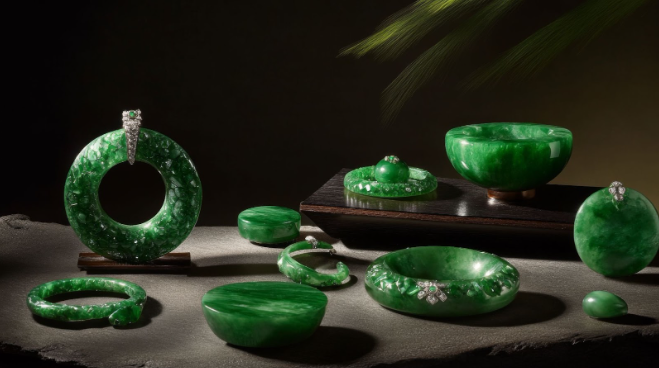Jade is one of the most recognisable gemstones in Asia, symbolising purity, protection, and wealth. For centuries, it has been carved, worn, gifted, and passed through generations. In Singapore, jade jewellery continues to evolve with contemporary fashion, gaining popularity beyond traditional circles. But beneath its elegant surface lie surprising truths about jade—its origin, value, and what people mistakenly believe. If you think you know jade, these ten revelations might change your perspective.
1. Not All Jade Is the Same Mineral
When people refer to jade, they often think it’s a single material. In reality, jade consists of two distinct minerals—jadeite and nephrite. Jadeite is rarer, harder, and valued more highly. Nephrite, while still beautiful, is more abundant and softer. The two look similar to the untrained eye, but they differ in structure and price. Most premium jade in Singapore is crafted from jadeite due to its vibrant colour and clarity.
2. Colour Isn’t Just Green
Although green is the most iconic shade, jade comes in many hues—lavender, white, yellow, black, and red. Lavender jade, in particular, has seen a rise in demand for its soft, feminine appeal. The colour depends on mineral content and trace elements. Surprisingly, some of the rarest jade isn’t green at all. When choosing a jade bangle or jade bracelet, understanding the value of each hue helps avoid overpaying for lesser-quality stones marketed as rare.
3. Jade Can Be Treated—But Sellers May Not Say So
Not every piece of jade is natural. Some are treated through bleaching, dyeing, or polymer injections to enhance colour and texture. These treatments affect durability and reduce long-term value. While treated jade may look appealing, it lacks the resilience of untreated jadeite. Reputable sellers label treated pieces clearly, but others may not disclose modifications. Buyers should request certification, especially for high-value items like a jade ring intended as an heirloom.
4. Authentic Jade Is Difficult to Distinguish
Without testing tools, it’s almost impossible to differentiate between authentic jade and imitations. Some fakes are made from dyed quartz or glass and passed off as jade. Even experienced collectors rely on gemological testing to verify authenticity. In Singapore’s competitive market, where jade pieces vary widely in price, knowing the source and requesting authenticity reports are essential when investing in higher-grade jewellery.
5. The Sound Test Is Still Used by Experts
A traditional way to test jade is by tapping two pieces together. Real jade produces a deep, resonant sound, while fakes tend to sound dull or tinny. Though not foolproof, this method remains a quick check used by many sellers. However, it’s no substitute for lab verification—especially when purchasing a fine jade bracelet or bangle with sentimental or financial value.
6. Jade Has Cultural Value Beyond Fashion
Wearing jade isn’t simply about appearance. In many Asian cultures, it represents protection, prosperity, and balance. Jade bangles are often gifted to children for safety and to brides as a blessing. In recent years, this symbolism has expanded into modern gifting practices, with jade rings used in engagement settings or milestone celebrations. Understanding jade’s cultural significance helps buyers appreciate its deeper value beyond aesthetics.
7. Price Isn’t Always Based on Size
A large piece of jade doesn’t guarantee high value. Clarity, translucency, and colour consistency are more important than sheer volume. A small, well-cut bangle of fine jadeite may cost more than a bulky but opaque one. Many buyers new to jade in Singapore assume that bigger means better—when in truth, finer details determine worth.
8. Jade Is Hard—but Can Still Crack Easily
Despite its strength, jade has a crystalline structure that makes it prone to shattering if dropped or hit at certain angles. This fragility surprises many owners who assume jade is unbreakable. Extra care must be taken with items like a jade bangle, which are rigid and vulnerable to impact. Storage, wear, and transportation all require careful handling.
9. Vintage Jade Can Outperform New Pieces in Value
Jade passed down through generations often carries more value than newer pieces, especially if it’s untreated and well preserved. Older pieces may also display carving techniques or motifs no longer in production. This heritage aspect contributes to pricing, making estate jade sought after among collectors.
10. Demand for Jade Is Rising Among Younger Buyers
Jade isn’t stuck in tradition. In Singapore, young buyers are embracing jade through minimalist design and fusion styling. Stackable jade bracelets, adjustable rings, and modern cuts are giving the stone new life in the fashion world. As designers reinterpret jade for contemporary wear, its relevance continues to grow.
Rethink What You Know About Jade
Jade is far more complex, precious, and culturally rich than its smooth surface suggests. Whether you’re wearing it for fashion, gifting it with meaning, or collecting it for investment, knowing these truths enhances your understanding of what makes jade special. In Singapore, where jade remains deeply rooted yet forward-looking, the right piece is more than just an accessory—it’s a story, a symbol, and a connection to heritage.
Explore authentic jade jewellery with confidence—contact Gen.K Jewelry for expert guidance and certified selections.



